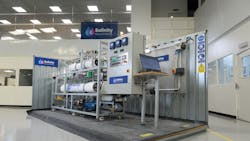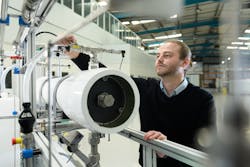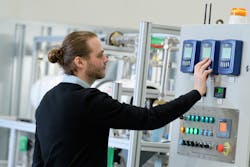Only 0.5% of the earth’s water is in the form of available fresh water. As populations rise and climate changes, water scarcity is becoming increasingly acute and not just in developing countries.
While 98% of people living in high-income countries have access to a safe, uncontaminated supply of water on tap, this figure drops to 30% in Sub-Saharan Africa. And in low-income countries, almost 6% of people depend solely on surface water to drink — that is any body of water above ground, including streams, rivers and lakes. An estimated 2 billion people, 26% of the global population, live in water-stressed countries, according to UN Water.
Even in countries with continental climates, like the USA, the outlook for water sustainability is concerning: the number of water-stressed areas are forecasted to grow significantly by the year 2040. It sends a stark warning that even the most developed nations are at increasing risk of droughts and that the need to recycle our precious water has become increasingly important. But as water reuse is set to increase, what of the added energy burden that recycling could create?
The energy equation
Over the next 25 years, the amount of energy used by the global water sector is projected to double, to 1,500 trillion-Watt hours (TWh). The supply, distribution and treatment of water will account for 4% of the world’s total electricity consumption. For at least the next decade, most of this energy will be generated from non-renewable sources such as gas and coal.
In California, for example, the energy cost of water is particularly expensive. In an article in The American Journal of Public Health, the numbers are pretty clear: Pumping, treating, transporting and heating California’s water currently represents nearly 20% of the state’s energy use.
Transporting water via California’s State Water Project — the state-built water delivery and storage system — is 2 to 3% of the state’s total energy alone and results in roughly 4 million tons of greenhouse gas emissions per year.
If more recycled grey water is used, the potential energy savings could be huge. If 10% of imported water in California was replaced by recycled water, there would be a savings of 80 million kWh of energy annually, approximately $20 million at today’s prices.
Nationally, it is estimated that some 9% of U.S. carbon emissions are related to transporting water, and that heating water totals 58% of the country’s water usage energy footprint.
That is why the grey water opportunity is clear.
Water reuse around the globe
In Europe, new legislation adopted in 2020 aims to encourage the reuse of wastewater, while defining requirements for a minimum quality throughout the European Union. The ambition here is quite substantial.
“Potentially, we could reuse 6.6 billion cubic meters of water by 2025, as against 1.1 billion every year at the moment,” according to the European MP, Simona Bonafè.
Singapore is currently a world leader in tackling the issue of wastewater. Recycled wastewater there now meets 40% of the country’s water demand, a figure that is expected to rise to 55% by 2060, according to Singapore’s national water agency.
The need to recycle wastewater is becoming a critical, global problem as water shortages spread through the world. Recycling wastewater is the only way to avoid future water shortages and decrease the damage that water pollution is doing to the environment.
However, the problem needs to be addressed without exacerbating the global energy crisis.
Across the world, emerging technologies are being developed to eliminate insoluble particles and soluble pollutants from wastewater.These treatment technologies including physical, chemical, biological (bioremediation and anaerobic digestion), and membrane technologies, among others.Batch reverse osmosis technology
One example of an organization developing emerging technologies for wastewater treatment is Salinity Solutions.
Based in the United Kingdom, Salinity Solutions is a spinout from the University of Birmingham, and has developed a technology to reduce the high carbon footprint of water treatment.
It uses batch reverse osmosis (RO) water treatment technology to reduce energy consumption, purify more water and generate less wastes to reach the carbon footprint reduction. The unit is also compact and transportable.
Salinity Solutions has identified more than 20 sectors across the globe that its patented solution can potentially benefit, ranging from municipal wastewater treatment to high-value mineral extraction, healthcare, food processing and industrial waste, to agriculture and rural drinking water.
During its first field trial, the technology helped geo-technology company Cornish Lithium to concentrate lithium found in shallow well geothermal waters in Cornwall, a previously untapped resource.
The system was able to help support lithium extraction from brine. The compact footprint of the system meant minimal impact on the landscape. Combined with high energy efficiency, the project benefitted from an all-around cleaner operation.
The company’s SAM50 system provides a wide range of solutions for environmental clean-up, water recycling, mineral extraction and ultrapure water.
Further field trials this year will be run across a range of different water treatment applications, including municipal water reuse, food processing, mineral extraction and agriculture.
This water treatment technology has the potential to benefit many applications, from industrial wastewater to high value mineral extraction and rural drinking water.
New, emerging technologies will have a major role to play in the global race to maintain enough water for communities’ survival. As climate change impacts weather conditions, and populations grow causing demand for water to increase, the need to recycle and reuse this precious resource has never been greater.
About the Author
Tim Naughton
Tim Naughton is co-founder and chief technical officer of U.K. tech startup, Salinity Solutions. Tim co-developed the company’s batch-process reverse osmosis technology while studying for his mechanical engineering degree. He was recently included in the TechRound ‘29Under29’ list of the top tech entrepreneurs in the UK.


